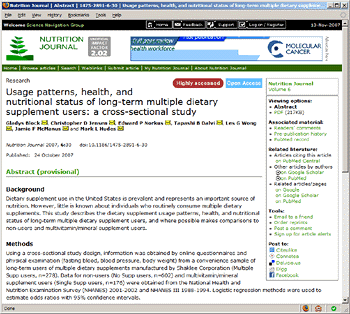 A recent article published in BioMed Central’s open access Nutrition Journal concerning the usage patterns of dietary supplements and the health and nutritional status of their users has been downloaded from the journal’s website over 16,000 times since publication on October 24th.
A recent article published in BioMed Central’s open access Nutrition Journal concerning the usage patterns of dietary supplements and the health and nutritional status of their users has been downloaded from the journal’s website over 16,000 times since publication on October 24th.
These remarkable access statistics demonstrate the extent to which open access journals can enhance the dissemination of
research, and emphasize the readiness of members of the public to dig behind the media coverage to read original research articles when they are accessible.
Ben Goldacre, on his excellent Bad Science blog, recently discussed the contrasting case of a research article, published in the Journal of the American Medical Association (JAMA) and widely covered in the popular media, which reported on the relative effectiveness of acupuncture, "sham acupuncture" and standard medical treatment in the treatment of lower back pain.
Lower back pain, like nutritional supplement usage, is an issue of relevance to a large fraction of the general population. Despite this, however, Goldacre’s attempts to persuade JAMA to make the article freely available so that the public could read it for themselves were unsuccessful – particularly problematic considering that, as discussed by Goldacre, much of the media coverage failed to convey the key result of the research, which was that there was no statistically significant difference in the effectiveness of ‘real’ and ‘sham’ acupuncture.
Public access to relevant medical research is not the only benefit of open access publishing, but it is a significant one. For other examples of recent articles that have attracted a wide readership, see BioMed Central ‘Most viewed’ page.
2 Comments